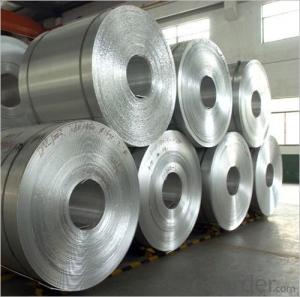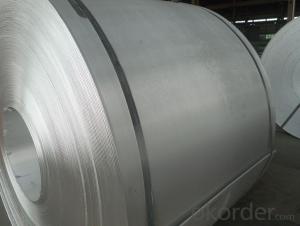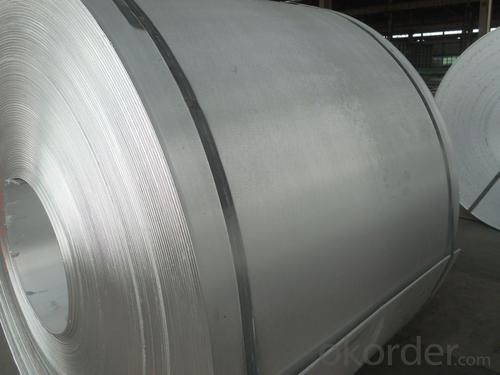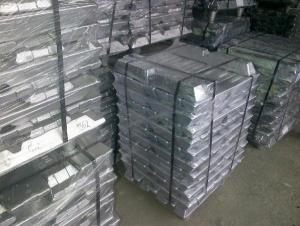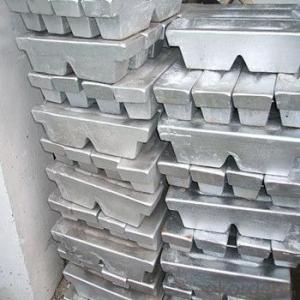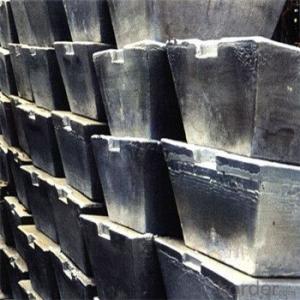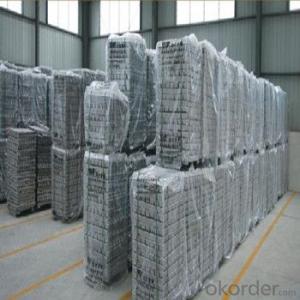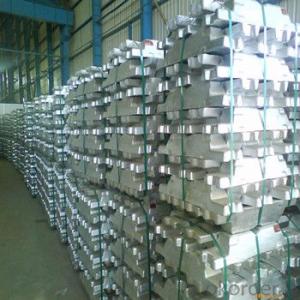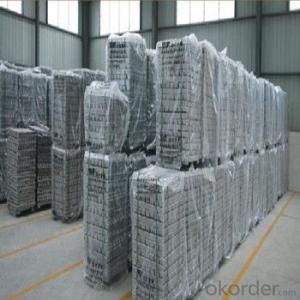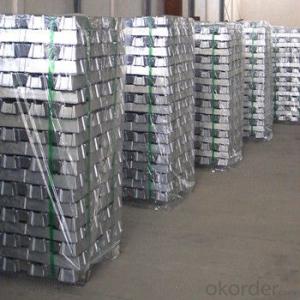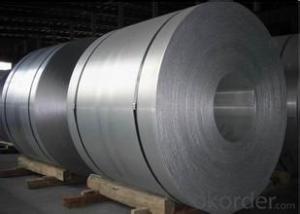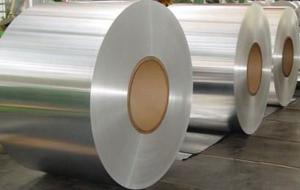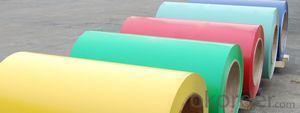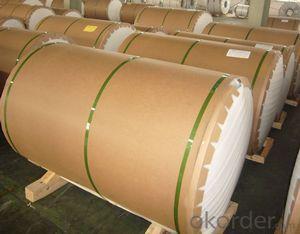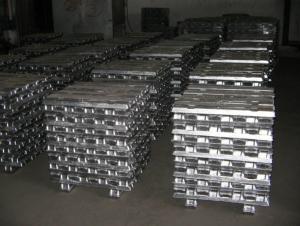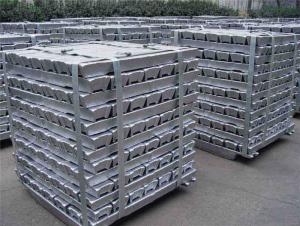Aluminum casting coil AA1070=P1020 for melt
- Loading Port:
- Tianjin
- Payment Terms:
- TT OR LC
- Min Order Qty:
- 200 m.t.
- Supply Capability:
- 5000 m.t./month
OKorder Service Pledge
OKorder Financial Service
You Might Also Like
Aluminium alloys (or aluminum alloys; see spelling differences) are alloys in which aluminium (Al) is the predominant metal. The typical alloying elements are copper, magnesium, manganese, silicon, tin and zinc. There are two principal classifications, namely casting alloys and wrought alloys, both of which are further subdivided into the categories heat-treatable and non-heat-treatable. About 85% of aluminium is used for wrought products, for example rolled plate, foils and extrusions. Cast aluminium alloys yield cost-effective products due to the low melting point, although they generally have lower tensile strengths than wrought alloys. The most important cast aluminium alloy system is Al–Si, where the high levels of silicon (4.0–13%) contribute to give good casting characteristics. Aluminium alloys are widely used in engineering structures and components where light weight or corrosion resistance is required
Specification:
Alloy: AA1070
Temper: F
Thickness:6mm—100mm
Width: 900mm—2300mm (Can be slitted)
Inner Diameter: 508MM
Coil Weight: AS REQUIRED
Application: MELT FOR LINGOTE TO MAKE ALUMINUM COIL O PLATE
Features:
1. Excellent quality of products
2. Quick delivery
3. Best service to clients
4. BV,SGS avalible
5. No buckle o waveness
6. Tension leveling
7. Certificate of Origin
8. Form A,E,F
Packaging Detail:
Carton ,Wooden pallet with plastic protection packing ,standard seaworthy packing or as your request.
Production Capacity:
Annual Production capacity of 600,000 tons.
Products are exported to United States, Canada, U.A.E, Brazil, Mexico,Thailand, Vietnam, Nigeria etc, over 100 countries and regions all over the world.
Production Line:
CNBM aluminum production base is comprised of 18 aluminum annealers, 10 coil and foil mills, 4 continuous production lines, 2 hot rolling production line and 3 prepainted lines.
FAQ:
1. What is the form of payment?
Normally 30% TT, 100% L
/C AT SIGHT
2. Type of quotation?
FOB, CFR, CIF
3. Port of loading?
Any port in China
4. Delivery time?
30 day after client’s deposit
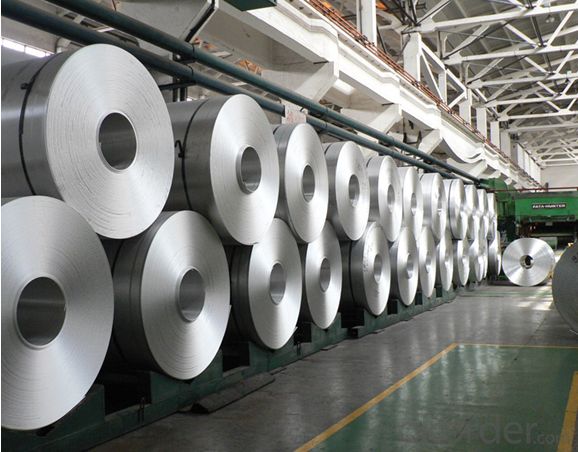
- Q: What are the different surface treatment options for aluminum ingots?
- Some of the different surface treatment options for aluminum ingots include anodizing, powder coating, painting, polishing, and sandblasting.
- Q: Can aluminum ingots be used in medical applications?
- Yes, aluminum ingots can be used in certain medical applications. Aluminum is lightweight, non-toxic, and has excellent corrosion resistance, making it suitable for medical devices such as orthopedic implants, prosthetics, and surgical instruments. However, it is important to note that aluminum should meet specific medical grade standards to ensure its safety and compatibility with biological systems.
- Q: What is the impact of alloying elements on the properties of aluminum ingots?
- Alloying elements have a significant impact on the properties of aluminum ingots. These elements are added to aluminum during the alloying process to enhance its mechanical, physical, and chemical properties. One of the main effects of alloying elements is the improvement of strength and hardness. For instance, the addition of elements like copper, manganese, and zinc can increase the strength of aluminum, making it suitable for applications that require high structural integrity. On the other hand, the addition of magnesium can enhance both the strength and hardness of aluminum, making it ideal for structural components in industries such as aerospace and automotive. Alloying elements also play a crucial role in improving the corrosion resistance of aluminum. Elements like chromium, copper, and silicon form a protective oxide layer on the surface of aluminum, which prevents the metal from corroding in harsh environments. The addition of these elements increases the lifespan of aluminum ingots, making them more durable and reliable in various applications. Moreover, alloying elements can influence the thermal conductivity and electrical conductivity of aluminum. Elements like copper and silicon enhance both thermal and electrical conductivity, making aluminum alloys suitable for heat exchangers, electrical conductors, and electronic components. Furthermore, alloying elements can affect the casting and machining characteristics of aluminum ingots. Elements like silicon and magnesium improve fluidity during casting, reducing defects and improving the overall quality of the final product. Additionally, the presence of certain elements can affect the machinability of aluminum, making it easier or more challenging to shape and process. In conclusion, alloying elements have a profound impact on the properties of aluminum ingots. They enhance strength, hardness, corrosion resistance, thermal and electrical conductivity, and influence casting and machining characteristics. Therefore, the choice and composition of alloying elements are critical in determining the suitability of aluminum ingots for specific applications.
- Q: What is the weight of a standard aluminum ingot?
- The size and dimensions of a standard aluminum ingot determine its weight, which can vary. Nonetheless, a typical benchmark for aluminum ingots is approximately 22.5 kilograms or 50 pounds.
- Q: How are aluminum ingots used in the production of modular buildings?
- Due to their unique characteristics and properties, aluminum ingots play a vital role in the production of modular buildings. These ingots are melted and then converted into different components, including beams, columns, panels, and other structural elements, which are used to construct the modular units. One advantage of aluminum is its lightweight nature, making it an ideal choice for modular construction. Aluminum ingots are significantly lighter than steel but still offer excellent strength-to-weight ratio, ensuring the durability and stability of the modular building. Furthermore, this lightweight characteristic allows for easier transportation and assembly of the modules, resulting in reduced construction time and costs. Additionally, aluminum provides exceptional corrosion resistance, which is particularly advantageous for modular buildings that may be exposed to harsh weather conditions or coastal environments. This resistance to corrosion guarantees that the building will maintain its structural integrity and appearance for a longer period, reducing the need for maintenance and repair. Moreover, aluminum ingots are highly versatile and can be easily molded and shaped into various forms and sizes. This flexibility enables architects and designers to create innovative and customized modular building designs that meet different functional and aesthetic requirements. Furthermore, aluminum can be easily recycled, making it a sustainable choice for modular construction projects that align with the growing demand for environmentally friendly and energy-efficient buildings. To summarize, aluminum ingots are used in the production of modular buildings due to their lightweight, corrosion-resistant, versatile, and sustainable properties. These ingots are transformed into various components that provide strength, durability, and flexibility to the modular units, facilitating faster construction, reducing costs, and ensuring long-term performance.
- Q: Where can I get aluminium ingots in cans?
- Although aluminum prices now have to rise, but now is high, a large number of aluminum ingots, and some hot money funds customs Tun once sold, small is the crowning calamity. Cautious.
- Q: What are the advantages of using aluminum ingots in the production of aircraft structures?
- There are several advantages of using aluminum ingots in the production of aircraft structures. Firstly, aluminum is known for its lightweight properties. This is crucial in the aerospace industry as it helps reduce the overall weight of the aircraft, leading to improved fuel efficiency and lower operating costs. The use of aluminum ingots allows manufacturers to create lightweight yet strong structures, enabling aircraft to carry more payload or fly longer distances. Secondly, aluminum has excellent corrosion resistance. Aircraft are exposed to various environmental factors such as moisture, humidity, and temperature fluctuations. Aluminum's natural corrosion resistance helps protect the aircraft's structure from degradation over time, ensuring durability and longevity. Additionally, aluminum ingots offer high strength-to-weight ratio. This means that even though aluminum is lighter than most metals, it still possesses remarkable strength. This property is crucial in aircraft structures, as it allows engineers to design components that can withstand the stresses and forces experienced during flight, ensuring the safety of passengers and crew. Moreover, aluminum is highly malleable and can be easily formed into complex shapes. This flexibility in manufacturing allows for intricate designs and precise engineering, enabling the production of aerodynamically efficient and structurally sound aircraft structures. It also simplifies the assembly process, reducing production time and costs. Furthermore, aluminum is a widely available and cost-effective material. Its abundance makes it easily accessible for manufacturers, ensuring a steady supply chain. Additionally, its cost-effectiveness allows for more affordable aircraft production, making air travel more accessible to a larger population. In conclusion, the advantages of using aluminum ingots in aircraft structures include lightweight properties, corrosion resistance, high strength-to-weight ratio, malleability, and cost-effectiveness. These characteristics make aluminum an ideal choice for aerospace manufacturers, contributing to the overall efficiency, safety, and affordability of aircraft production and operation.
- Q: How are aluminum ingots used in the production of cookware?
- Aluminum ingots play a crucial role in the production of cookware due to their unique properties. These ingots are melted down and then shaped into desired cookware forms, such as pots, pans, and baking sheets. One of the main reasons aluminum is widely used in cookware production is its excellent heat conductivity. Aluminum conducts heat more efficiently than other metals, which ensures even heat distribution across the entire surface of the cookware. This property allows for consistent cooking results, preventing hotspots and reducing the risk of food burning or sticking to the pan. Moreover, aluminum is lightweight and easy to handle, making it a popular choice for cookware. This feature is particularly beneficial for individuals with limited strength or mobility, as it enables them to maneuver and lift the cookware without much effort. However, pure aluminum is relatively soft and susceptible to scratches and dents. To improve its durability, aluminum ingots are often alloyed with other metals, such as copper or stainless steel, during the cookware manufacturing process. These alloys enhance the strength and hardness of the cookware while retaining the excellent heat conductivity of aluminum. Additionally, aluminum is non-reactive, meaning it does not interact with acidic or alkaline foods. This characteristic ensures that the taste and quality of the cooked food are not affected by the cookware material. Furthermore, aluminum cookware is generally affordable, making it accessible to a wide range of consumers. Its cost-effectiveness, combined with its excellent cooking performance, has made aluminum cookware a staple in many kitchens around the world. In conclusion, aluminum ingots are indispensable in the production of cookware due to their excellent heat conductivity, lightweight nature, and non-reactive properties. By utilizing aluminum ingots, manufacturers can create cookware that provides even heat distribution, durability, and affordability to enhance the cooking experience for consumers.
- Q: What are the energy requirements for producing aluminum ingots?
- Several factors, such as the production process, energy source, and facility efficiency, can influence the energy requirements for producing aluminum ingots. Generally, the production of aluminum ingots is known to be an energy-intensive process. The primary method used to produce aluminum ingots involves smelting aluminum oxide, or alumina, obtained from bauxite ore. The most commonly used method is the Hall-Héroult process, which includes electrolyzing alumina dissolved in a molten cryolite electrolyte. To carry out this process, a significant amount of energy is needed to heat the alumina to its melting point of approximately 2,040 degrees Celsius and maintain this temperature. Typically, large electric currents are passed through the molten electrolyte to provide the necessary energy for electrolysis. Moreover, the production of aluminum ingots requires a substantial amount of electrical energy to break the chemical bonds in alumina and separate the aluminum metal from the oxygen. The electrolysis process consumes significant electricity, making aluminum production one of the largest global consumers of electrical energy. The source of electricity used can also influence the energy requirements for producing aluminum ingots. Utilizing renewable energy sources like hydropower, wind power, or solar power can significantly reduce the environmental impact and carbon footprint of aluminum production. Conversely, if non-renewable sources like coal or natural gas are used to generate electricity, the energy requirements may increase, contributing to higher greenhouse gas emissions. Over the years, efficiency improvements and technological advancements have been made in aluminum production processes, resulting in reduced energy consumption. For instance, the introduction of pre-baked anode technology has enhanced the energy efficiency of the Hall-Héroult process. Additionally, recycling aluminum requires significantly less energy compared to primary production from bauxite ore, making it a more sustainable and energy-efficient option. In conclusion, the energy requirements for producing aluminum ingots are significant due to the high temperatures required for smelting and the electricity needed for electrolysis. However, technological advancements and the adoption of renewable energy sources can help decrease energy consumption and minimize the environmental impact of aluminum production.
- Q: What are the common uses of aluminum ingots?
- Due to their unique properties, aluminum ingots find a wide range of common uses. One industry that heavily relies on aluminum ingots is the automotive industry, where they are utilized in the manufacturing of various products. Engine components like cylinder heads and engine blocks, as well as body panels and wheels, are made from aluminum ingots. This is because the lightweight nature of aluminum helps improve fuel efficiency and reduce vehicle weight. The construction industry also benefits from the use of aluminum ingots. It is used to fabricate window frames, door frames, roofing materials, and structural elements. Aluminum's high resistance to corrosion makes it suitable for outdoor applications, and its lightweight nature allows for easy installation and transportation. In the packaging industry, aluminum ingots play a vital role. They are used to make cans for beverages and food items because of their excellent barrier properties, which protect the contents from light, moisture, and air. Additionally, aluminum cans are easily recyclable, making them a sustainable choice. The electrical industry also heavily relies on aluminum ingots. They are utilized in the production of power transmission lines, electrical wiring, and conductors. Aluminum's high electrical conductivity and low weight make it an ideal material for conducting electricity efficiently and cost-effectively. Lastly, the aerospace industry benefits from the use of aluminum ingots. The lightweight yet strong characteristics of aluminum make it an excellent choice for manufacturing aircraft components such as wings, fuselages, and structural parts. The weight reduction achieved with aluminum significantly improves fuel efficiency and overall performance. In conclusion, aluminum ingots have diverse applications in various industries, including automotive, construction, packaging, electrical, and aerospace. Its versatility, strength, and lightweight nature make it an essential material in modern manufacturing processes.
Send your message to us
Aluminum casting coil AA1070=P1020 for melt
- Loading Port:
- Tianjin
- Payment Terms:
- TT OR LC
- Min Order Qty:
- 200 m.t.
- Supply Capability:
- 5000 m.t./month
OKorder Service Pledge
OKorder Financial Service
Similar products
Hot products
Hot Searches
Related keywords
